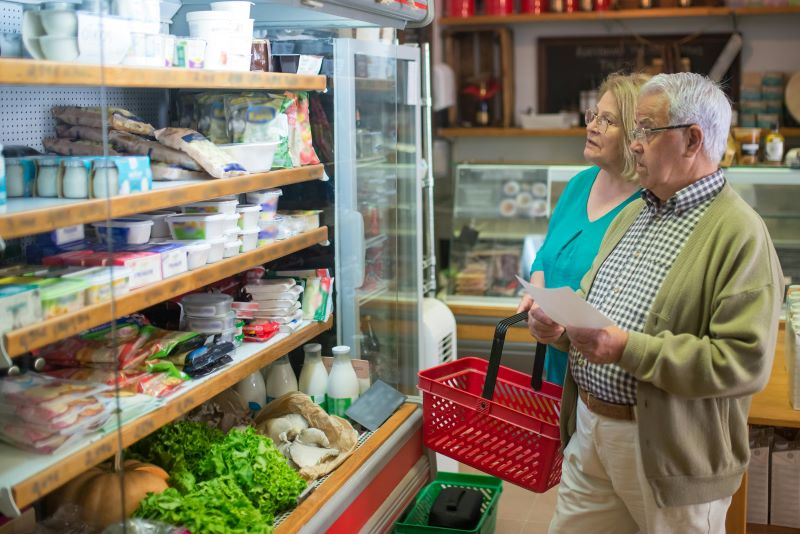How To Save Money on Groceries: Practical Tips & Government Assistance
Grocery prices keep climbing, and many families feel the squeeze every week at checkout. According to the Bureau of Labor Statistics, food costs are now about 2.9% higher than in 2024
With tariffs and import costs pushing up everyday staples like coffee, sugar, and bananas, the big question is: how to save money on groceries? This guide explores smart grocery-saving strategies and government programs that can make a real difference.
1. How To Save Money on Groceries with Government Programs
For families struggling to make ends meet, government assistance programs offer more than just a safety net. They’re one of the best ways to save money while ensuring healthy food makes it to the table.
Two of the most widely used programs are SNAP and WIC:
1.1 SNAP: A Lifeline for Your Grocery Budget
The Supplemental Nutrition Assistance Program (SNAP) helps millions of low-income households afford nutritious food every month.
Benefits are delivered through an Electronic Benefit Transfer (EBT) card, which works like a debit card and can be used at authorized grocery stores, farmers markets, and even some online retailers.
Below’s an overview of SNAP program:
- Eligibility: SNAP is income-based, with specific limits depending on household size and state. Applicants must also meet residency and citizenship requirements.
- What you can buy:
- Fruits and vegetables
- Meat, poultry, and fish
- Dairy products
- Bread and cereals
- Snacks and non-alcoholic drinks
- Seeds and plants that grow food for your household
- What you cannot buy:
- Alcohol, tobacco, and controlled substances
- Vitamins, medicines, and supplements
- Hot foods prepared for immediate consumption
- Nonfood items like pet food, cleaning supplies, or cosmetics
By focusing on essentials and healthy staples, SNAP EBT ensures families can keep nutritious meals on the table while cutting down on grocery expenses.

1.2 WIC: Healthy Food and Support for Women, Infants, and Children
The Special Supplemental Nutrition Program for Women, Infants, and Children (WIC) goes beyond groceries. It’s tailored for pregnant women, new mothers, and young children, ensuring they receive vital nutrition during critical growth stages.
With a WIC EBT card, participants get access to free and healthy groceries such as fresh fruits, vegetables, milk, baby food, beans, cheese, and eggs.
But WIC doesn’t stop there. It also offers valuable support services designed to make life easier for families:
- Nutrition Education: Families receive meal planning support and personalized healthy eating tips.
- Breastfeeding Support: One-on-one guidance from skilled staff helps new mothers with feeding practices.
- Health Referrals: WIC connects families to medical, dental, and community health resources.
- Convenience: Many states now offer virtual appointments to make accessing WIC even easier.
This program is especially valuable because it combines financial savings with professional guidance, helping families develop long-term healthy habits.
1.3 Bonus: Save Even More with SNAP and WIC Benefits
Beyond groceries, participating in SNAP or WIC can unlock extra savings. Both programs can qualify households for Lifeline, a federal initiative that reduces monthly phone and internet bills. Here’s how:
- SNAP participants automatically qualify nationwide as part of Lifeline’s eligibility criteria.
- WIC participants may also qualify in certain states, such as California.
- By applying through providers like AirTalk Wireless or TAG Mobile, households may even receive a free or discounted device such as a smartphone or tablet.
With Lifeline, families who qualify through SNAP or WIC can cut household expenses further while staying connected.

>>> Read more: Free Tablet with SNAP Benefits: How to Get One
2. Grocery Budgeting Methods to Try
Alongside government programs, adopting structured budgeting methods can help families stretch every dollar. Here are three simple but effective approaches you can try right away.
2.1 The 3-3-3 Rule for Groceries
What is the 3-3-3 rule for groceries? It’s a simple method that encourages families to divide their grocery budget into three equal parts. This way, you can control overspending effectively:
- ⅓ for proteins: meat, poultry, fish, or plant-based options like beans.
- ⅓ for fruits and vegetables: fresh, frozen, or canned.
- ⅓ for staples and extras: dairy, grains, cereals, and snacks.
Let’s try this with an example: if your monthly budget is $300, you’d set aside $100 for proteins, $100 for produce, and $100 for staples. This approach keeps spending balanced across food groups while ensuring your meals stay nutritious.

2.2 Spend Only $100 a Month on Groceries
How to spend only $100 a month on groceries? Some individuals and small households challenge themselves to spend just $100 per month by carefully planning meals and cutting waste. The idea isn’t to deprive yourself but to be resourceful.
- Plan meals ahead and use a shopping list to avoid extras.
- Cook from scratch instead of buying processed meals.
- Shop discount stores and look for weekly deals.
For example, you could buy bulk staples like rice and oats, then pair them with budget-friendly proteins such as beans, eggs, or lentils. By stretching ingredients this way, $100 can go surprisingly far.
2.3 The 5-4-3-2-1 Method for Grocery Shopping
What is the 5-4-3-2-1 method for grocery shopping? This approach makes weekly shopping simple and structured, helping you stay on track and avoid going over budget. Each trip, aim to put these in your cart:
- 5 fruits and vegetables
- 4 proteins (meat, fish, eggs, beans, or tofu)
- 3 grains (bread, rice, pasta)
- 2 dairy products (milk, cheese, yogurt)
- 1 treat (something small for enjoyment)
Let’s make an example: if you’re shopping for the week, you might grab apples, bananas, carrots, spinach, and broccoli; add chicken, eggs, tofu, and beans for protein; pick up rice, pasta, and bread as your grains; include milk and cheese for dairy; and finally, a bar of chocolate as your treat.
This way, your cart stays balanced and your budget stays in check.
3. Extra Tips on How to Save Money on Groceries
Beyond budgeting methods and assistance programs, a few everyday strategies can help lower your food bill without compromising on quality:
- Avoid impulse buys: Stick to your list and shop with intention.
- Cook in batches: Preparing meals ahead saves both time and money.
- Freeze extras: Leftovers or bulk purchases can be stored for later.
- Buy in bulk: Essentials like rice, pasta, and beans are cheaper in larger quantities.
- Switch to store brands: Generic labels often cost less but taste just as good.
- Shop seasonal produce: Fruits and vegetables are cheaper and fresher in season.
- Use store loyalty programs: Rewards and digital coupons can add up to significant savings.
These small shifts in habits can combine to make a noticeable difference in your monthly grocery bill.
>>> Check more: New Food Stamp Rules: Junk Food Bans, Work Requirements
Final Words
Rising food prices can make it difficult to manage a household budget, but learning how to save money on groceries can make a real difference. From government assistance programs like SNAP and WIC to simple budgeting strategies and everyday shopping tips, there are many ways to stretch your dollars while keeping nutritious meals on the table.
And remember: if you’re enrolled in programs like SNAP or WIC, you may also qualify for Lifeline benefits through providers such as AirTalk Wireless or TAG Mobile – even more ways to reduce your monthly expenses.
